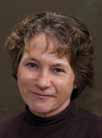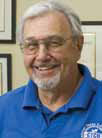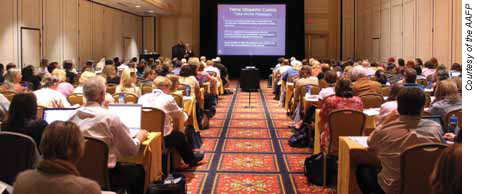AAFP reaches out with feline health information
Cat-friendly practices, use of nonsteroidal anti-inflammatory drugs in cats, and feline neurology and ophthalmology are just a few of the topics that the American Association of Feline Practitioners has tackled recently.
In the coming months, the AAFP and CATalyst Council will be working to help small animal practices become more cat-friendly in an effort to reverse a decline in feline veterinary visits (see story). Guidelines on the long-term use of NSAIDS in cats are the first product of a partnership between the AAFP and International Society of Feline Medicine.

The AAFP's fall conference, Sept. 10-13 in New Orleans, attracted 325 attendees. The meeting focused on the examination and treatment of cats with neurologic and ophthalmologic diseases.
While the AAFP is not very large—at a little over 1,900 members—it has been producing a wealth of continuing education, guidelines, and other resources on feline health.
AAFP resources
Dr. Elizabeth J. Colleran, AAFP president, said the association seeks to increase its membership while establishingitself as the nation's leader in feline health. The AAFP is recruiting all veterinarians who treat cats, not just feline-only practitioners.
Dr. Colleran said the AAFP's unofficial mantra is: "If you see one cat a year, you're a feline practitioner." Currently, she said, more than 60 percent of AAFP members work in general small animal practice.
The AAFP also is extending its reach by collaborating with other organizations. Dr. Colleran said the new partnership with the ISFM is important for providing resources on feline health. The ISFM, formerly the European Society of Feline Medicine, is the veterinary division of the United Kingdom's Feline Advisory Bureau, which pioneered the concept of the cat-friendly practice.
The AAFP and ISFM collaborated to create consensus guidelines on the long-term use of NSAIDs in cats. The guidelines appeared in the July issue of the Journal of Feline Medicine and Surgery, the journal of both organizations. The special report provides a comprehensive review and panel recommendations on use of NSAIDs in cats. A client handout accompanies the report.
Dr. Andrew H. Sparkes, chair of the Feline Advisory Bureau, delivered a presentation and webcast about the new guidelines during the AAFP's fall conference.
The AAFP plans to offer more webcasts, Dr. Colleran said. "We keep asking ourselves: 'How do we become more effective at disseminating information on feline issues to the veterinary world at large?'"
One answer is the AAFP's new approach of holding one meeting a year rather than two, starting in 2011, so the association can offer more CE at other conferences.
In addition to CE, the AAFP has been producing a number of resources on feline health. The AAFP and American Animal Hospital Association released the "AAFP-AAHA Feline Life Stage Guidelines" early this year. Now the AAFP is developing guidelines on "Feline Handling Techniques: Methods to Reduce Stress on Cats While in the Veterinary Practice."
The AAFP released position statements on a variety of topics during the past year, many containing recommendations and a great deal of background information. The most recent statement addresses "Transport of Cats" by providing principles on containment methods, adjusting the cat to the carrier, and general welfare considerations for transport. In the works is a position statement regarding indoor environmental enhancement.
Looking to the next generation of members, the AAFP also is maintaining its outreach program for veterinary students.
"It's really about elevating the attention that's paid to feline health issues in the mind of new veterinarians," Dr. Colleran said.
Fall conference
The AAFP's fall conference focused on neurologic and ophthalmologic issues at the request of attendees at past meetings, said Dr. Roberta K. Lillich, chair of the AAFP program committee.




"It's an area of practice where many people feel like their skills can be improved," Dr. Lillich said. "The cases themselves can be confusing to work through from a diagnostic standpoint."
Dr. Chantal J. Mullins was the subcommittee chair for the fall conference. Sessions on neurology addressed neurologic examination of the cat, diseases that affect the cat's brain, examination of the cat's gait, and diseases that affect the cat's gait. Sessions on ophthalmology addressed ocular examination, ocular diseases, and systemic diseases that affect the eye as well as ophthalmic surgery and ocular emergencies.
Dr. Larry M. Kornegay, AVMA president, installed the new officers during the AAFP's fall conference. Joining Dr. Colleran as AAFP officers are Drs. Donna Stephens Manly, Chapel Hill, N.C., president-elect; Roy B. Smith, Round Rock, Texas, secretary-treasurer; and Lorraine K. Jarboe, Fort Walton Beach, Fla., immediate past president.
Dr. Kornegay also provided an update on AVMA activities during the conference. He wrote afterward, "This was another near 'purrfect' meeting for the AAFP, with some exceptional speakers and continuing education."

Next fall, Dr. Lillich said, the AAFP will hold a joint meeting in Boston with the ISFM and Feline Advisory Bureau. The CE at the conference will focus on cardiovascular disease.
Early next year, the AAFP will again offer a track at the North American Veterinary Conference. In 2012, the AAFP will begin offering a track at the AAHA meeting.
"Our goal is to have AAFP program committee members involved in coordinating those tracks so that the caliber of the CE and the information that the veterinarians are getting is directly impacted by AAFP—since we are known for being the resource for all things related to feline medicine and surgery," Dr. Lillich said.
Information about the AAFP, including practice guidelines, is available at www.catvets.com.